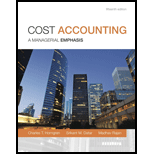
1.
Variance analysis is the process of ascertaining the deviations between actual and planned output.
Favorable Variance:
A circumstance that happens when a foreseen cost is higher than its real cost, or when expected income is lower than real income
Unfavorable variance:
Unfavorable variance is the difference between the actual and planned output which is harmful for the company like actual cost incurred is more than the standard or planned cost or the revenue is less than the planned revenue.
Direct Material Price Variance:
Direct material price variance in the difference between the budgeted per unit cost of raw material and the actual per unit cost multiplied by the number of units purchased.
Direct Material Efficiency Variance:
Direct material efficiency variance is the difference between the budgeted quantities and the actual quantities purchased at a specific price.
Material Price Variance:
Material price variance is the difference between the budgeted and the actual purchase price of the material purchased. It is calculated to ascertain the efficiency of the purchase department.
Direct Labor Efficiency Variance:
Direct labor efficiency variance is the difference between the actual time consumed in manufacturing unit and the standard time allowed or the budgeted time for the manufacture of a unit multiplied by the standard direct labor rate.
To calculate: The variable
2.
To calculate: The fixed overhead spending and production volume variance and indicate whether each is favorable (F) or unfavorable (U).
3.
To comment: On overhead variances and to identify the firm is to be worried about its control over technology spending or not.
Want to see the full answer?
Check out a sample textbook solution
Chapter 8 Solutions
Cost Accounting, Student Value Edition (15th Edition)
- The activity based overhead rate used to assign the costs?arrow_forwardNonearrow_forwardPrecision Manufacturing has a total factory overhead budgeted at $750,000 for the upcoming fiscal year. The company produces two types of window coverings: blackout drapes and sheer panels. Each product requires 6 direct labor hours to manufacture. Management has projected a production of 10,000 units for each product type. Determine the factory overhead allocated per unit for blackout drapes using the single plantwide factory overhead rate.arrow_forward
- O Company acquired a building valued at $195,000 for property tax purposes in exchange for 13,000 shares of $6 par common stock. The stock is selling for $14 per share. At what amount should the building be recorded? Helparrow_forwardI am looking for the correct answer to this general accounting question with appropriate explanations.arrow_forwardMorrison Industries estimates that annual manufacturing overhead costs will be $1,200,000. The estimated annual operating activity bases are direct labor cost of $650,000, direct labor hours of 60,000, and machine hours of 120,000. Compute the predetermined overhead rate for each activity base. (Round answers to 2 decimal places, e.g., 10.50% or 10.50.) = . Overhead rate per direct labor cost- . Overhead rate per direct labor hour = $ . Overhead rate per machine hour = $ %arrow_forward
- Please provide the accurate answer to this general accounting problem using valid techniques.arrow_forwardWhich of the following is an example of an operating activity?A) Issuing stockB) Borrowing moneyC) Purchasing equipmentD) Receiving cash from customersexplarrow_forwardHow can I solve this financial accounting problem using the appropriate financial process?arrow_forward

 AccountingAccountingISBN:9781337272094Author:WARREN, Carl S., Reeve, James M., Duchac, Jonathan E.Publisher:Cengage Learning,
AccountingAccountingISBN:9781337272094Author:WARREN, Carl S., Reeve, James M., Duchac, Jonathan E.Publisher:Cengage Learning, Accounting Information SystemsAccountingISBN:9781337619202Author:Hall, James A.Publisher:Cengage Learning,
Accounting Information SystemsAccountingISBN:9781337619202Author:Hall, James A.Publisher:Cengage Learning, Horngren's Cost Accounting: A Managerial Emphasis...AccountingISBN:9780134475585Author:Srikant M. Datar, Madhav V. RajanPublisher:PEARSON
Horngren's Cost Accounting: A Managerial Emphasis...AccountingISBN:9780134475585Author:Srikant M. Datar, Madhav V. RajanPublisher:PEARSON Intermediate AccountingAccountingISBN:9781259722660Author:J. David Spiceland, Mark W. Nelson, Wayne M ThomasPublisher:McGraw-Hill Education
Intermediate AccountingAccountingISBN:9781259722660Author:J. David Spiceland, Mark W. Nelson, Wayne M ThomasPublisher:McGraw-Hill Education Financial and Managerial AccountingAccountingISBN:9781259726705Author:John J Wild, Ken W. Shaw, Barbara Chiappetta Fundamental Accounting PrinciplesPublisher:McGraw-Hill Education
Financial and Managerial AccountingAccountingISBN:9781259726705Author:John J Wild, Ken W. Shaw, Barbara Chiappetta Fundamental Accounting PrinciplesPublisher:McGraw-Hill Education





